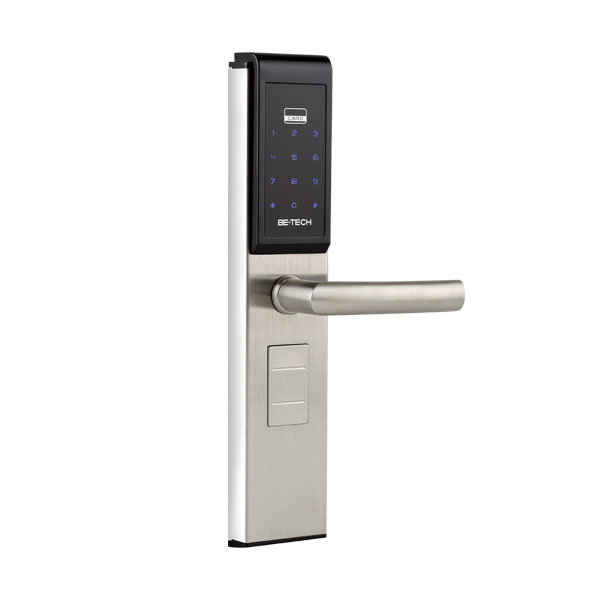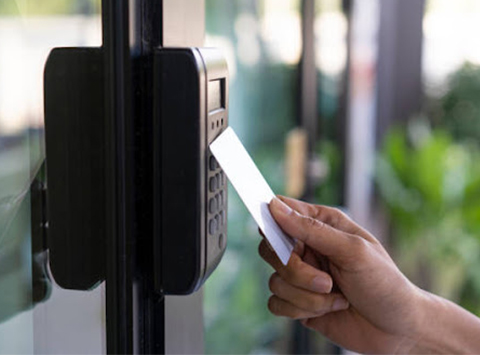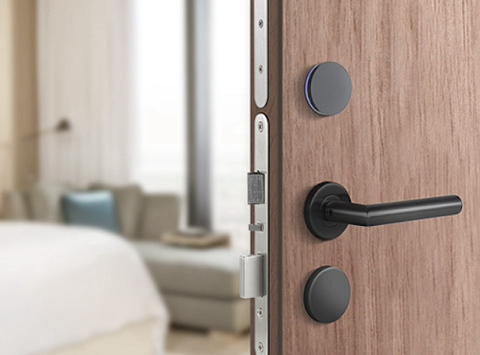Property administration is a complex endeavor that necessitates a great deal of care and attention. In addition to relying on the owner to keep the property safe, the tenants expect an easy and quick admissions process. Choosing the right access control system can significantly improve the organization’s ability to carry out the responsibilities outlined below. RFID door locks may be useful in achieving these objectives.
RFID card door locks are defined in this article, along with an explanation of how they work. The section that follows discusses the advantages and disadvantages of using RFID door locks, provides an overview of the RFID door locks that are currently the most popular on the market, and discusses a variety of other access control options.
What Is an RFID Door Lock?

RFID technology is used for many things, like keeping track of inventory and processing payments. RFID door lock systems are widely used in the security industry for access control because they give users a reliable, consistent experience and provide data that can be tracked. RFID locking systems are contactless, which means that the credential doesn’t have to touch the reader for it to work. This is different from other common access control methods, such as swipe cards.
RFID readers send and receive data in the same way that barcode readers do, but instead of scanning a barcode to send information, radio waves are used. RFID door locks need RFID tags, antennas, an RFID reader, and a transmitter for the system to work as a whole.
In an RFID door lock access control system, the user’s ID, which is usually a keycard or fob with an RFID chip, has a tag on it that is a unique piece of identifying data. When a user gets close to an RFID tag, the signal from the reader finds it and sends it to antennas and transceivers so that the tag can be authorized in the access control system.
The system will either let the user open the door after reading the request or tell the user that she/he can’t. An access control system can keep track of who comes and goes because data from an RFID-enabled system is automatically saved.
What RFID Door Lock Should Include?
RFID tag
A transponder, or RFID tag, is a small device that stores a string of specific digital data. This set of data validates a resident’s identity. An RFID tag is embedded in a credential, which is typically a card or fob.
Credential reader
Credential readers read data from credential cards and send it to a control panel. The most important component is an antenna, which allows a credential reader to communicate with the tag.
Control panel
The control panel serves as the central processing unit for the RFID door lock system. Control panels determine whether a credential matches or not after maintaining a database containing all credential information. When a resident moves in or out, staff can modify access permissions and database changes using the control panel.
How Do RFID Door Locks Work?
RFID door locks use radio waves to connect a credential and a reader. The reader determines whether a renter is authorized to enter the room or building after they present their credentials to the lock.
Building managers must program and assign a unique credential to each renter for an RFID door lock system. Administrators must also deactivate credentials if a tenant misplaces or abandons them.
RFID door locks, like smart locks, are a type of wireless and electronic access control system. The difference is that tenants can unlock inter
net- or Bluetooth-connected smart locks with their smartphones. When using radio-frequency identification (RFID) locks, renters must use a physical device, such as a plastic fob or key card.
RFID Door Lock Pros and Cons

RFID door locks make it easier for residents to gain access. Do the advantages of RFID technology, however, outweigh the disadvantages? Furthermore, can RFID locks benefit employees and property managers? Continue reading to learn about the benefits and drawbacks of RFID door locks.
Pros:
Easy to replace credentials
Undoubtedly requires a steady supply of replacement keys or fobs as new tenants move in or existing tenants lose their keys or fobs. Furthermore, unlike traditional metal keys, creating a new key card for a tenant is simple by using onsite equipment.
Convenience for tenants
Using an RFID card or fob is far more convenient than fumbling with a key. Because some RFID readers can read a tag without the user touching it, the advantages of contact-free door entry systems will also appeal to the building’s health-conscious tenants.
Simple to administer
Several doors within a building can be programmed to communicate with a single RFID key card. In addition to an inside amenity such as a gym, the owner may grant access to a resident’s flat. Instead of making separate key cards for each room, the owner can program a single key to open multiple doors.
Cons:
Credentials are easily lost
Tenants frequently misplace their RFID credentials, just as they do their brass keys. Residents may appreciate the convenience of a fob or key card, but they are likely to misplace them. Residents must take time out of their busy schedules to change their fob when this occurs. This suggests that the benefits of convenience for residents are not as great as they appear.
Credentials are insecure
Are RFID door locks vulnerable to hacking? Unfortunately, the answer is yes. RFID credentials are undeniably easier to obtain than traditional keys. However, a quick Internet search reveals that anyone can purchase an RFID copying machine for around $15, increasing the risk of security breaches on the property.
No way to manage visitor entry
One of the most important functions of an access control system is to control visitor entry. Residents today must deal with a never-ending influx of visitors, ranging from close friends to dog walkers to delivery couriers. Residents cannot remotely authorize a visitor’s access or verify a visitor’s identity when using an RFID door lock.
Visitors cannot access RFID door locks, which are sufficient for residents. Smart locks that are Internet-connected, on the other hand, enable owners to provide digital access credentials and virtual keys to trusted visitors for easy admission.
Features to Look For in an RFID Door Lock

Which characteristics are most relevant to the user will depend on specific situations. Others want access to their home when they’re not there, but some want more security in the event of a power outage or a remote hacking attempt. The owner’s goals will dictate how he/she will weigh these options.
A Program to Control Access
The owner can control the smart lock with a smartphone app. This allows them to remotely open and close doors and grant visitors access as needed even when they are not present. Automating this process with an app saves time, effort, and money.
Keys With Reprogramming
Have the ability to reprogramme the key card if the owner wants to be able to distribute keys whenever the need arises. This enables the owner to offer access to other individuals without constantly needing to order fresh cards for them.
NFC door locks, which are a sort of RFID lock, provide an additional layer of protection. If the card is taken and disabled it, the criminal will not be able to use it.
Time-Limited Access
For many people, simply granting or refusing access is insufficient. Many users choose to change the settings depending on when they need access. For example, the owner may wish to provide temporary keys to guests attending a specific event that are only valid for that event. This capability is facilitated by NFC door locks because it can be implemented remotely without requiring physical reprogramming of the locks.
Auto-Lock After a Predetermined Time
One of the most important characteristics to look for in a lock is its ability to automatically lock itself after being opened. Even if someone remotely unlocks the front door, they must be able to close it before leaving so that no one else can gain access through an open door. This feature is critical for Airbnb hosts because it protects their homes while they are away.
Anti-tamper Features
Strong anti-tamper measures should also be considered to protect anyone’s belongings. What happens if an intruder is unable to enter the home? Will an alarm that could scare them away or remotely alert the owner if something is wrong at home go off?
What security features does the door lock have? When the home is vacant, this helps to protect and deter intruders. Find a lock that does this effectively, as this is the purpose of smart locks in general.
Passcode Support
It is sometimes necessary to give someone access without providing them with a physical key or phone. Young children may be untrustworthy with phones or have difficulty finding their keychain. Require a method to grant temporary access under certain conditions without changing the lock’s settings.
Passcodes can be used to limit access by providing simple, quick, and easy-to-remember combinations for all parties involved, regardless of app experience.
Physical Keys in Case of Emergency
A physical key is essential in the event of an emergency or a power outage that renders NFC door locks inoperable. These locks are ultimately the responsibility of computers. Computers, too, can fail. If one needs to get into the house after a power outage or when the NFC system isn’t working, the person needs a key or someone who can let them in another way.
Where Can RFID Door Locks Be Used

RFID access control technology is applicable to a wide range of applications, particularly facility security. Almost everyone has certainly used an RFID entry system in a hotel, office building, or apartment complex. Examine a few examples of how RFID technology improves security and operations in a variety of industries.
RFID Door Lock for Home
Homeowners are constantly looking for ways to improve the comfort and safety of their homes. RFID home door locks are an excellent way to achieve both goals. RFID is an abbreviation for Radio Frequency Identification. Access control, asset tracking, and contactless payments are just a few of the industries that use this technology.
RFID door locks communicate with a tag attached to the user’s keychain, credit card, or phone via an electromagnetic field. When the tag gets close to the lock, it automatically unlocks. This is an excellent method for gaining access to the home without having to search for the keys. Furthermore, because it cannot be picked or forced open, it is more secure than a traditional keyed lock.
RFID Door Lock for Commercial
RFID is a very useful office access technology. RFID magnetic door locks are now used in the majority of commercial office buildings, particularly those with multiple tenants or hotels. Instead of replacing and retooling locks after each lease expiration, commercial property owners can manage a changing tenant list more efficiently with key cards and fobs that can be programmed relatively easily.
RFID door locking systems for corporate offices are more adaptable than other security systems because they can handle different employee access levels. RF hotel card lock system allows hotel owners to manage hotels better and effectively, which could better ensure the safety of tourists.
Because touchless technology is quickly becoming essential for offices to feel safer, the contactless feature of an RFID door lock access control system provides tenants and employees with peace of mind. The readers and credentials of a standard onsite RFID door locking system are controlled by regional servers and networks.
Cloud-based platforms that integrate RFID entry systems, on the other hand, enable remote configuration and maintenance, which aids in the reduction of vacancy rates in commercial office buildings. Remote capabilities simplify the management of multiple locations from a single dashboard on the same cloud-hosted network, which is an important use case for multi-site enterprises.
Recommended RFID Door Locks for Home and Commercial
Here are some of the best RFID door locks that they could check out for maximum security:
1. Recommended RFID Home Door Lock
BE-TECH Fingerprint & RFID Card & Touchpad Digital Door Lock

Looking for a digital door lock that uses touchpad, RFID card, and fingerprint technology? BE-TECH is an excellent choice. This device is appropriate for both home and business use, and installation is simple.
The RFID card eliminates the need to fumble with keys, and the touchpad makes entering a code simple.. Only those with the necessary credentials can gain access due to the fingerprint sensor’s enhanced level of security.
2. Recommended RFID Home Door Lock
BE-TECH Electronic Hotel Lock -Visual III RFID

The most recent electronic locks are from the Be-Tech VISUAL III RFID series, which are simple, fashionable, and comfortable to use. Be-Tech created the VISUAL III RFID series for modern and appealing hotels, ensuring that the lock blends in beautifully with the upscale hotel environment.
The stunningly beautiful location is not just for show. The matte black finish of the Be-Tech VISUAL III RFID series allows architects and designers to maximize the fashion sense of hotels while elevating the user experience to an entirely new level.
Alternatives to RFID Door Locks
RFID door locks are a smart choice that may appeal to tech-savvy residents. RFID door locks also offer more features and conveniences than a traditional metal lock and key. Superior options for electronic access control systems are available.
Mobile-Phone Controlled Home Door Lock (Bluetooth Door Lock & WiFi Door Lock)
For both employees and tenants, the most practical option is a smartphone-compatible access control system. Residents can now unlock doors with their smartphones, saving the owner’s staff the cost of constantly issuing and replacing RFID keys or fobs.Only need to download an app, connect with the lock system, then you could use mobile phone to unlock the door.
Fingerprint Door Lock
Fingerprint door locks are becoming increasingly popular among homeowners looking for an alternative to the traditional keyed entry system. Although RFID door locks are an option, fingerprint door locks have a number of advantages that make them the preferred choice for many people.
One of the most significant advantages of fingerprint door locks is that they cannot be duplicated as easily as key locks. This eliminates the possibility of someone copying the key and gaining access to the home. Fingerprint door locks provide a higher level of security because they require an exact match to unlock the door. Someone with an RFID tag identical to the one pre-programmed into the lock may be able to gain access using an RFID door lock system.
Keypad Door Lock
The best keypads are mobile device compatible. Install keypads at secondary entrances, amenity rooms, and other common areas to manage access. Residents can use their mobile device to open keypad-equipped doors. Furthermore, they can generate and distribute temporary PIN numbers or virtual keys on their mobile devices to allow guest access.
FAQ about RFID Door Lock

How to Unlock RFID Door Lock?
Fortunately, there are several methods for getting around an RFID lock. The first method is to use the master key. To open the lock if one has the master key, simply hold it up to it.
The second method is to use a magnetic key. A magnetic key can be made by placing a strong magnet on the back of the hand. When the magnet is placed near the lock, it will unlock.
A wireless key fob is the third option. When a wireless key fob is held up to the lock, it unlocks.
How to Install RFID Door Lock?
Installing an RFID door lock is a simple process that can be completed in a matter of minutes. The first step is to remove the existing door lock from the door. Once the old lock is removed, the new RFID lock can be installed in its place. The next step is to connect the power supply to the new lock. Finally, the new lock needs to be programmed with the desired access codes.
What Advantages Can Rfid Door Locks Offer?
There are numerous advantages to using an RFID door lock. The ability to generate temporary passcodes that can be shared remotely with friends allows for easy access permission management at all times. If one wants to improve the security of their homes, consider purchasing an RFID-enabled lock. This strategy is the most effective way to increase security without frequently changing locks.
Can an RFID Card Be Used While It Is Wet or Moist Outside?
Yes, even if it’s raining outside, the RFID lock can still be used. The RFID coil of wire is frequently encased in plastic and is frequently located within the card itself. Concerned that water or moisture will cause damage to the RFID door locks? Simply keep them away from these substances and use them as usual. Any high-quality front door RFID lock (including the ones we’ve just discussed) will, however, be weatherproof.
What Occurs When There Is a Power Outage?
The majority of RFID locks come with backup batteries, but a key can also be used as a backup. Living in an area where power outages are common? Keep extra keys on hand and understand how long the backup batteries in the door locks will last before they need to be replaced.
Will I Also Require a Key?
Yes, it is prudent to be prepared because one never knows when will the spare key be needed.
What Occurs if I Misplace My Card?
In the event of an emergency or if one accidentally lose the card, one only needs to enter the PIN or a backup key. However, it is recommended that one should disable a lost card so that unauthorized individuals cannot gain access to the home or office.
Is There More Than One Kind of RFID Card?
RFID employs a variety of frequencies, so anyone may come across cards that operate on different wavelengths than others. To unlock the door lock and grant access, the home card may use a 125 kHz or 900 MHz frequency, whereas the office card may use a 13.56 MHz frequency. To keep the information secure, various data storage formats and encryption techniques are used.
Can I Use My Key From Work to Get Into My House?
If the lock can read the frequency of the work key, it might be compatible. It is dependent on whether they use the same format and whether the management tool supports custom keys. This is an ingenious solution for frequent travelers who use different keys to open their home and business door locks at the same time. However, unless one goes out of his/her way to find a home lock that is compatible with the lock at the workplace, these products are unlikely to be compatible.
Conclusion
RFID door locks are useful for controlling access to individual units for renters who have pre-approved credentials. Nonetheless, because the property frequently has multiple entrances and shared amenity zones, the owner require a more robust access control system.
Furthermore, both residential and commercial tenants welcome delivery personnel and other visitors. As a result, a tenant-only access solution is insufficient. As an integrated solution, consider smart locks, keypads, and a smartphone-based door lock. Smart lock manufacturer BE-TECH could give you the integrated keyless lock solution.
The right access control solutions give residents the flexibility and resources they need to manage their own access experiences, while eliminating the costs associated with issuing credentials, saving time and money.
Check out BE-TECH if anyone needs dependable electronic door locks for apartments or offices & hotels. With close to 30 years under its belt, Be-Tech is a trusted digital door lock factory of high-quality keyless solutions and smart locks. Five continents are represented among the company’s clientele.
Blogs you may be interested in:
- Different types of smart locks
- Guide on the keyless electronic door lock
- Main door lock types for security
- Types of key card access system
- Deadbolt vs knob lock vs handle lock
- Bluetooth door lock buyers’ guide
- Types of combination locks
